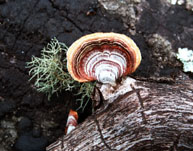The magic of mushrooms
Urban mushrooms are as sure a signal of spring as dandelions. They appear clumped on stumps and scattered on lawns to remind us that asphalt and grass make up a thin veneer covering the wild earth, which threatens to burst at the seams every May. To some, they are pests and enemies of propriety and order, but to others, they are beautiful organisms.

Turkey tail mushroom
Neither plant nor animal, fungi comprise their own kingdom. Unable to manufacture their own food, they seek out organic matter and release enzymes to break it down. Saprophytic fungi feed on dead material, while mycorrhizal ("tree-helper") fungi sheathe tree rootlets and engage in a nutrient exchange, providing the tree with phosphorous and other elements, while the tree provides them with carbohydrates.
Mushrooms only fruit sporadically and are painfully difficult to identify: one must rely on characteristics such as colour, size and shape of the cap, stem, gills and spores, as well as habitat, season and mycorrhizal partners. Other traits to observe are chemical staining or oxidation reactions, sliminess, odour, or rate of decomposition. Much of mycological science is devoted to the identification of these varied organisms.
Macdonald Campus mycologist Suha Jabaji-Hare got her start at the University of Waterloo, identifying mushrooms or parts of mushrooms that had poisoned people. (Mushroom toxins generally kill slowly and painfully by destroying the liver and/or kidneys.) Her current research area is molecular plant pathology. She has developed a technology that farmers can use to determine the presence and amounts of disease-causing fungi in agricultural soil. First, she extracts all DNA from the soil -- this can be plant, bacterial, animal, fungal or even human. Then she analyzes it using a DNA probe designed to recognize the particular fungus she is looking for. This method bypasses the time-consuming method of culturing soil samples, making it possible to diagnose the soil before the plants get sick. She also studies the beneficial fungi in soil that protect plants against destructive fungi, either by competing with them or by activating the plant's own immune system.
Every October, she teaches a class called Introduction to Fungi. The class consists of trips to the Morgan Arboretum to bring back mushrooms and identify them in the lab. At the end of the class, students hand in a portfolio, complete with dried sample specimens, permanent microscope slides showing spores and descriptions. And if they find edible mushrooms, do they get to eat them? "There is absolutely no tasting in my lab," says Jabaji-Hare. "It is too risky and some people are allergic even to edible mushrooms." Instead, students learn how to grow Pleurotus (oyster mushrooms) and shiitake mushrooms on sawdust substrate using kits, harvesting them when they fruit.
As for urban mushrooms, you may see Agaricus species popping up on lawns (the white "supermarket mushroom" is one of these), as well as various kinds of Coprinus, which digest themselves as a method of spore dispersal. For an even stranger method of propagation, find a stinkhorn, whose phallic head is covered with green spore-slime that stinks and attracts flies to spread it around. You may see rings of Marasmius areades, the "fairy ring mushroom," which grows in ever-widening circles. On the mountain or in the arboretum, you will encounter many kinds of bracket fungi, which eat dead wood and are themselves too tough and woody to eat. You may discover fungi that smell like garlic, anise, pepper, sperm, maple or phenol. The city is rich in mushrooms, and, like new words in your vocabulary, once you become aware of them, you begin to see them everywhere.
Hana Askren, McGill women's wrestling assistant coach, is an amateur mushroom hunter who has spotted many different varieties around campus, such as inky cap, pear-shaped puffball and turkey tail.
